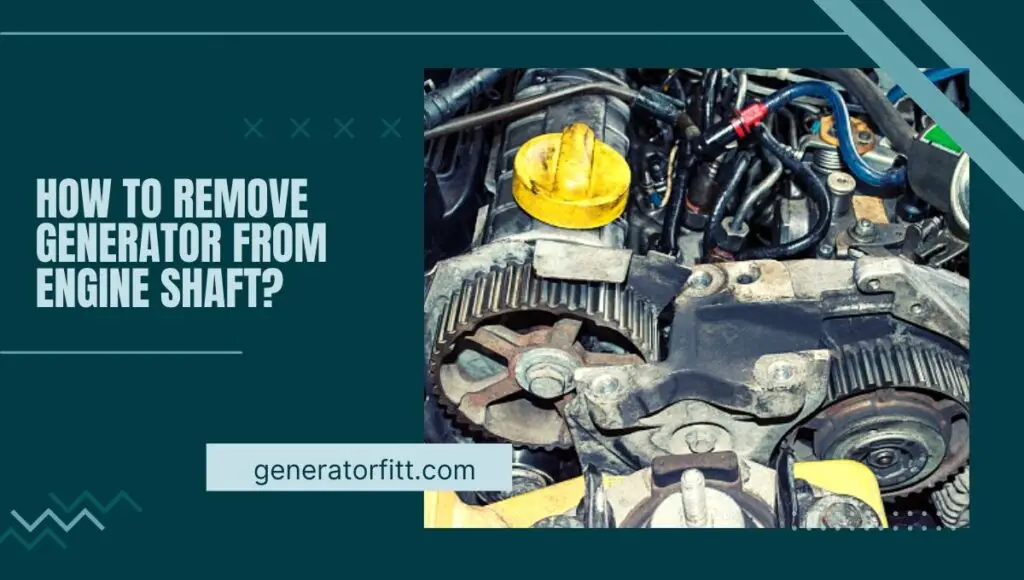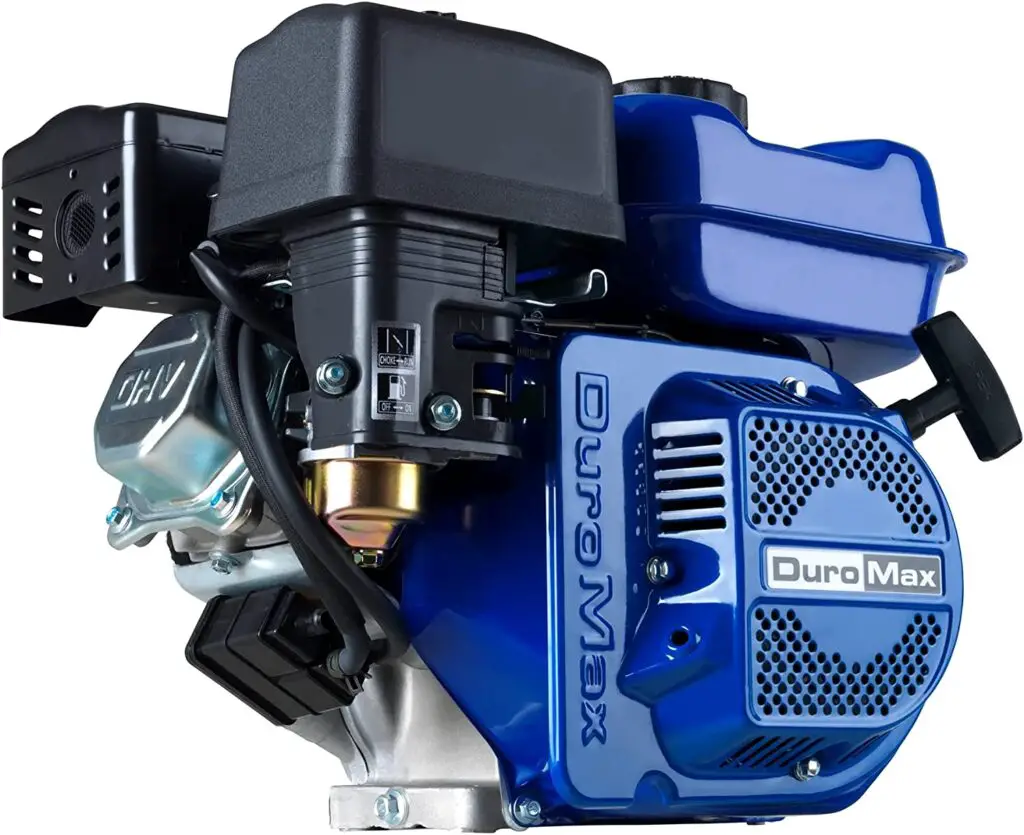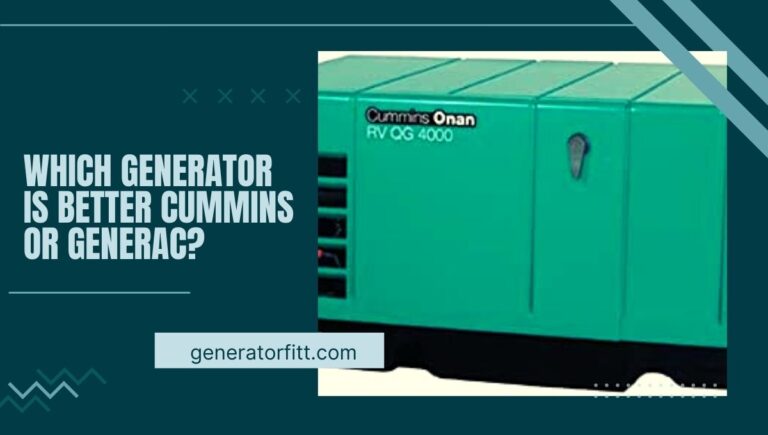How to Remove Generator From Engine Shaft? (Guide) In 2023
How to remove generator from engine shaft? If you are in need of removing a generator from your engine shaft, you may be wondering where to start and how to do it properly.
Whether it’s to replace a faulty generator or upgrade to a more efficient one, it’s important to follow the correct steps to ensure the removal process is safe and effective.
In this article, we’ll provide you with a comprehensive guide on how to remove a generator from an engine shaft. From gathering the necessary tools to disconnecting the electrical connections, removing the mounting bolts, and lifting the generator off the shaft, we’ll take you step-by-step through the process. So let’s get started!

How to Remove Generator from Engine Shaft?
How to Remove Generator from Engine Shaft? follow these steps:
- Disconnect the negative battery cable to prevent electrical shock or damage.
- Locate the bolts or screws that secure the generator to the engine. Depending on the make and model of the vehicle, the generator may be located in different positions, such as on top of the engine or on the side.
- Use the appropriate socket or wrench to loosen and remove the bolts or screws. Depending on the location of the generator, you may need to use a socket extension or universal joint to reach them.
- Once the bolts or screws are removed, gently pull the generator away from the engine to detach it from the shaft.
- If the generator is still stuck, use a pry bar or similar tool to gently pry it away from the engine.
- Once the generator is free, disconnect the electrical connectors and remove it from the engine compartment.
- Inspect the generator and engine shaft for any signs of damage or wear, and replace any components as needed.
These steps are general guidelines and may vary depending on the specific make and model of the vehicle. Always consult the vehicle’s owner’s manual or a qualified mechanic for detailed instructions.
DuroMax XP7HP 208cc Recoil Start Gas Powered 50 State Approved

The DuroMax XP7HP is a powerful and reliable gas-powered engine. With a displacement of 208cc, it provides ample power for a variety of applications.
The recoil start feature makes it easy to start up, ensuring a hassle-free operation. What sets it apart is its 50 State Approved status, meaning it complies with emissions regulations in all 50 states of the United States. Whether you need it for your generator,
pressure washer, or other equipment, the DuroMax XP7HP is a versatile and environmentally friendly choice.
Pros
- Powerful Performance: The DuroMax XP7HP features a robust 208cc engine that delivers ample power for a variety of applications, including powering small generators, water pumps, and other equipment.
- Recoil Start System: The engine’s recoil start system allows for manual starting by pulling a cord, eliminating the need for an electric starter or battery. This makes it reliable and easy to use, even in remote areas without electricity.
- 50 State-Approved Emissions: The DuroMax XP7HP is compliant with emission regulations in all 50 states of the United States. This approval ensures that the engine meets strict environmental standards, making it an environmentally-friendly option.
- Gasoline Convenience: Running on gasoline, the engine is compatible with a readily available fuel source, making refueling straightforward and convenient.
- Versatility: The engine’s design and power output make it versatile for use in various equipment, providing a cost-effective solution for multiple applications.
- Compact Size: Its compact and portable design allows for easy transportation and storage, making it ideal for users who require mobility and versatility.
Cons
- Limited Fuel Options: The engine only operates on gasoline and does not offer the versatility of alternative fuel choices, such as propane or natural gas.
- Durability: Some users have reported concerns about the long-term durability of the engine. It may require regular maintenance and proper care to ensure reliable performance over time.
Follow these steps by Steps Guide:
Here are steps by Steps Guide:
Gather the Necessary Tools
Before starting the removal process, it is important to gather all the necessary tools. You will need a set of wrenches, pliers, screwdrivers, and possibly a hammer or mallet.
You may also need a gear puller if the generator is attached to a gear or pulley. Make sure that you have all the tools you need before starting the removal process.
Disconnect the Battery
The first step in removing a generator from an engine shaft is to disconnect the battery. This will ensure that no power is running through the generator while you are removing it.
You can disconnect the battery by loosening the negative cable clamp and removing the cable from the battery terminal.
Remove the Electrical Connections
Next, you will need to remove the electrical connections to the generator. This will include disconnecting the wires that run from the generator to the battery,
as well as any other wires or connectors that are attached to the generator. Make sure to label these connections so that you know where they go when you are reassembling the generator.
Remove the Mounting Bolts
Once the electrical connections have been removed, you can move on to removing the mounting bolts. These bolts will be holding the generator in place, so it is important to loosen them carefully. Use a wrench or socket to remove the bolts, taking care not to damage the surrounding parts.
Remove the Generator
With the mounting bolts removed, you can now remove the generator from the engine shaft. Depending on the size and weight of the generator, you may need to enlist the help of another person to lift it off the shaft.
Make sure to lift the generator straight up to avoid damaging the engine shaft or surrounding parts.
Clean the Engine Shaft
Once the generator has been removed, you should take the time to clean the engine shaft. This will ensure that the new generator can be installed properly and securely. Use a clean rag or towel to wipe down the shaft, removing any dirt, debris, or residue.
Install the New Generator
Finally, you can install the new generator onto the engine shaft. Make sure to follow the manufacturer’s instructions carefully, and reattach all the electrical connections and mounting bolts.
Once the new generator is installed, you can reconnect the battery and test it to make sure that it is working properly. Removing a generator from an engine shaft can seem like a daunting task, but by following these simple steps, you can do it safely and effectively.
Make sure to gather all the necessary tools, disconnect the battery and electrical connections, remove the mounting bolts, lift the generator off the shaft, clean the engine shaft, and install the new generator properly.
By following these steps, you can remove a generator from an engine shaft with ease.
People also ask
How do you remove a generator armature from a motor shaft?
To remove a generator armature from a motor shaft:
Remove the generator from the engine.
Locate the retaining bolts or clips that secure the armature to the motor shaft.
Remove the retaining bolts or clips. Gently pull the armature away from the motor shaft.
If the armature is still stuck, use a puller tool designed for this purpose.
Once the armature is free, inspect it and the motor shaft for any signs of damage or wear.
How do you remove the armature from a portable generator?
To remove the armature from a portable generator:
Disconnect the spark plug wire and fuel line. Drain the fuel tank and oil from the engine.
Remove the generator cover and pull off the flywheel nut. Use a flywheel puller tool to remove the flywheel. Locate the retaining bolts or clips that secure the armature to the motor shaft.
Remove the retaining bolts or clips. Gently pull the armature away from the motor shaft.
If the armature is still stuck, use a puller tool designed for this purpose.
Once the armature is free,
inspect it and the motor shaft for any signs of damage or wear.
How do you put off a generator?
To turn off a generator, first, disconnect all electrical loads, let it run for a few minutes with no load to cool down, then turn off the circuit breaker or disconnect the electrical cord from the power source. Finally, turn the engine switch to the “OFF” position.
What is the difference between a generator and a main engine?
A generator is a device that converts mechanical energy into electrical energy, typically using fuel to power an engine that drives an alternator.
The electrical energy produced is typically used to power electrical loads such as lights, appliances, and tools.
On the other hand, a main engine (also known as a propulsion engine) is a machine that provides the power needed to propel a vehicle, such as a ship, airplane, or vehicle.
The main engine uses fuel to create mechanical energy, which is then converted into propulsion force to move the vehicle.
In short, the main difference between a generator and a main engine is that a generator produces electrical energy, while a main engine produces mechanical energy for propulsion.
However, some engines can serve as both generators and main engines, depending on their design and application.
Conclusion
In Conclusion, Removing a generator from an engine shaft is a relatively simple process if you have the right tools and follow the right steps.
By disconnecting the battery and electrical connections, removing the mounting bolts, and lifting the generator off the shaft carefully, you can remove the generator without causing any damage. With these steps in mind, you can successfully remove a generator from an engine shaft and install a new one if necessary.
Hi, I am Brines Loe and I am an Expert in Generators I have Experience in This Field I want to Help You About This Website! Welcome to our generator (Outdoor) Guide blog! We are dedicated to providing you with the latest information and tips on outdoor generators, ensuring that you have the knowledge you need to make informed decisions about which generator is right for you.






